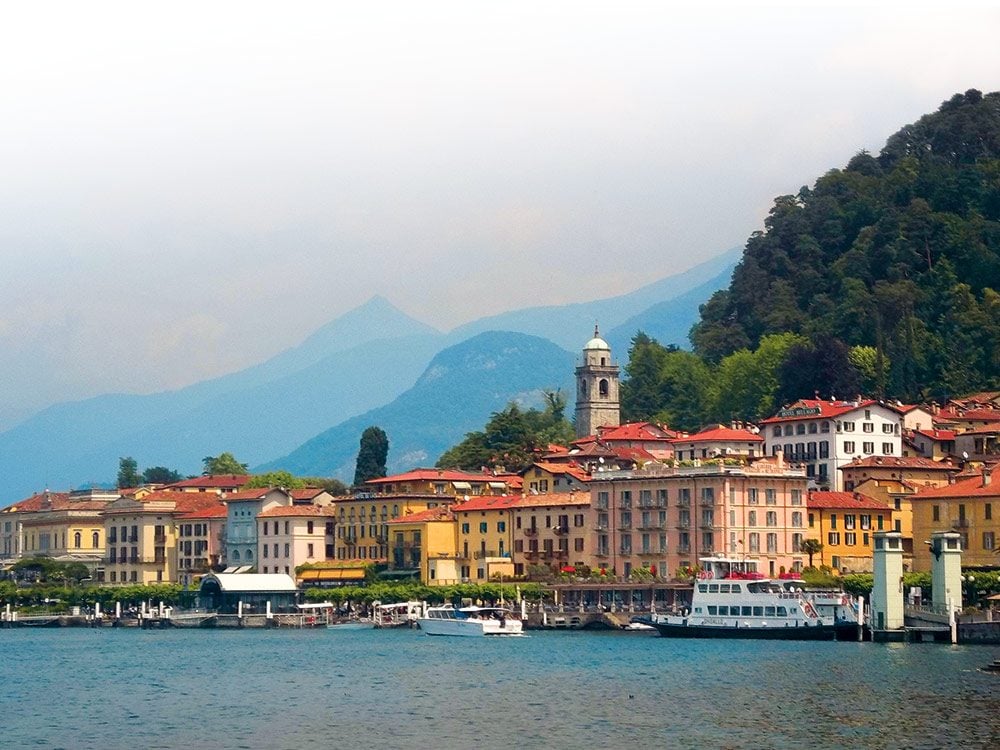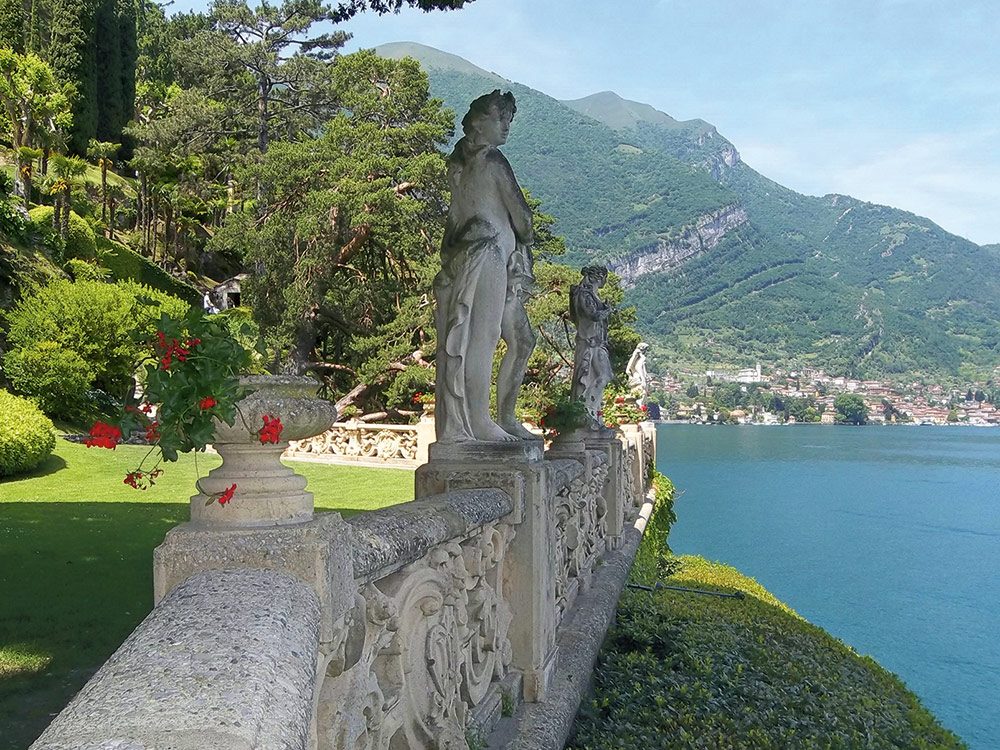
Welcome to Lake Como
The Lake Como region of northern Italy combines natural and manmade beauty—a place of allure. Whether you are a honeymooner, baby boomer or garden aficionado, I defy you not to be mesmerized by misty Lake Como. Little wonder that the Milanese, living only an hour away, escape here on weekends.
Bellagio, situated on a promontory jutting out into the centre of the lake, is a stellar attraction that was our home base for the week-long stay my boyfriend Bill and I enjoyed last May. You can unwind dining al fresco on an open-air terrace with jasmine cascading down the stone walls, and take the ferry to nearby towns, each of which possesses a unique character. The splendid villas enchant you with art treasures and magnificent Renaissance gardens.
Villa Carlotta (circa 1690) in nearby Tremezzo is a short ferry ride across the lake. Guarded by tall gates and statues of Roman gods, this grand mansion with its white exterior and refined neoclassical interior features an art gallery and salons rich with Napoleonic furniture, sculptures and a decorated domed ceiling. Francesco Hayez’ portrait “The Last Kiss of Romeo and Juliet” and Antonio Canova’s romantically erotic statue of Eros and Psyche are particularly captivating. This villa with its masterpieces and rich botanical garden featuring more than 500 plant species was once an important stop on “The Grand Tour,” a rite of passage undertaken by wealthy young students to complete their education in the 17th and 18th centuries. Today, many travellers come in spring to take in the drifts of azaleas and rhododendrons. The fountain and patterned Italianate garden are best viewed from the upstairs balcony. Waiting to be discovered on the villa’s four acres of land are a rock garden, a fern valley, rhododendron woods and a bamboo garden. Gazing at the lake from the café, a former greenhouse, Bill and I had a wonderful lunch surrounded by fragrant scarlet roses.
Later, we explored the nearby five-star Grand Tremezzo Hotel, attracted by its Art Nouveau façade. There are well-designed gardens, huge bouquets of long-stemmed roses in the public spaces and a sophisticated, glass-enclosed ristorante over the water.
This is the least-visited country in Europe—and it’s absolutely stunning.

Lake Como’s Villa del Balbianello
If you visit only one villa, make it Villa del Balbianello, perched on a romantic promontory. Until the 16th century, this property was home to Franciscan friars, a meditative place. After a short ferry ride to Lenno, we walked one kilometre from town along a forested, uphill path and were welcomed at the villa grounds by cypress sentinels and terracotta pots of hydrangeas and lemons. We sauntered along gravel paths to the golden-hued loggia with its minutely trimmed fig vines. The loggia forms a bridge between the library, with over 400 volumes on travel and geography, and the map room. The last owner, Guido Monzino, was an avid explorer of Mount Everest and the North Pole.
These gardens combine Renaissance elements—pattern, order, statuary and exotic plant material—then flow as an English landscape garden, naturally following the contours of the steep, irregular grounds. Their design fits the architecture and topography in a most harmonious way.
Rhododendron shrubs grow unfettered. Huge plane trees pruned in a candelabra shape alternate with wisteria and ivy to greet the visitor mooring at the marina. Swans swim by the majestic gates of the dock as deep pink fairy roses bloom. Visitors can easily climb up the path to the terrace shaded by laurel and boxwood. Villa del Balbianello is a serene place of respite that encourages one to linger.
Not to be outdone, Bellagio has its share of villas. Neoclassical Villa Melzi, a favourite of Franz Lizst, has a lavish Empire-style chapel. Its landscaped English gardens display drifts of azaleas in their pink glory in May. This garden was one of the first English-style parks on Lake Como. The lavish gardens of Villa Serbelloni, once home to Pliny the Elder (author, naturalist and commander of the early Roman Empire), cover much of the promontory on which Bellagio sits.
Some travellers use the ferry like a hop on/hop off water bus, viewing the exclusive private villas along the west side of the lake, such as George Clooney’s Villa Oleandra.
Villa d’Este (circa 1568) became a luxury hotel in 1873. Its Renaissance Garden placed it on our itinerary. We walked uphill along the water stairs to the grotto of Hercules. A statue of Athena and Telemachus (son of Ulysses) is splendid in its pink marble pavilion. The nymphaeum, a large wall-like mosaic of stones complete with a grotto, has sensuous erotic sculptures in an almost modern design.
Our last day in Lake Como, we ferried to Varenna and walked along the passerella—an elegant lakeside promenade. There are no streets in the old town, only steep-stepped lanes called contrade, reminding me of Positano.
We rested on a bench at Villa Cipressi, now a luxury hotel, and decided not to walk around the narrow terraced garden. Villa Monastero, once a convent, has magnificent gardens. Magnolias, yucca and camellias are among the highlights. By chance, we discovered Nilus Bar, a charming find by the water with an ivy-covered shaded patio, wrought-iron chairs and fabulous food. As I savoured their caprese salad with fresh, creamy buffalo cheese and tomatoes tasting just-picked from the garden, Lake Como sparkled in the twilight, leaving a lasting impression in my mind.
Next, discover more of Italy’s most beautiful small towns and lakes.